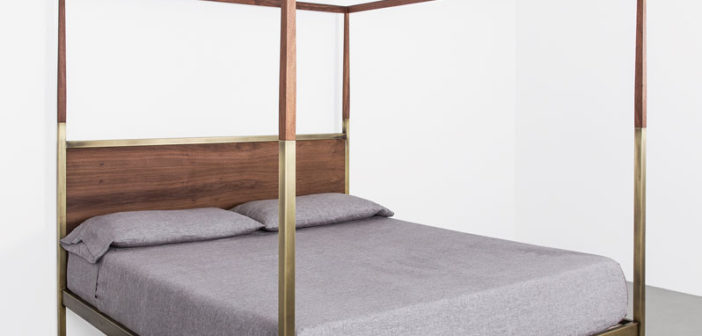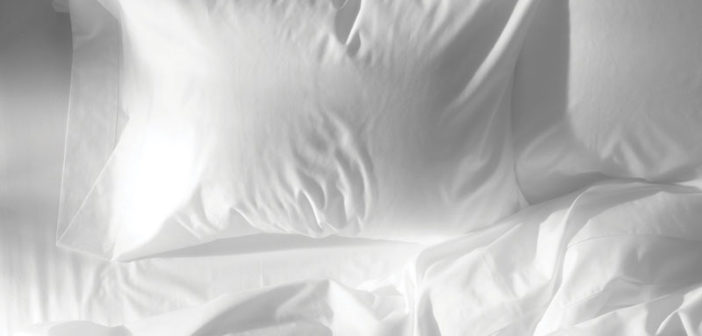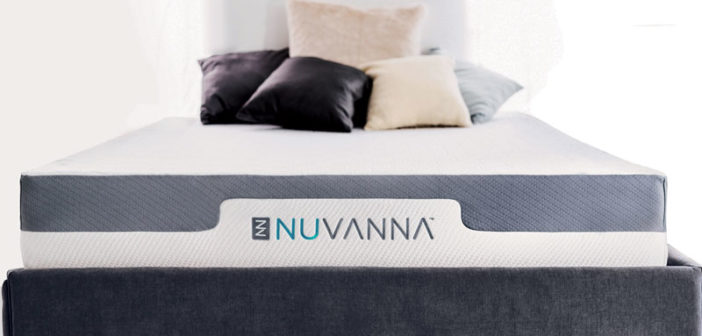While guests may like to go to the lobby to enjoy a cocktail or coffee, socializing and working simultaneously, or hit the gym to burn some calories, the guestroom is the heart of the hotel experience—and the bed is at the center of that. After all, a night of poor, interrupted sleep would set anyone on the wrong foot for the rest of the day. So what are hotels doing to create the optimal guestroom stay?
“The bed is central to a positive guest experience,” said Tony Hochschild, president, Sterling Sleep Systems, pointing to the success of Westin’s Heavenly Bed program. “That illustrates the strong influence comfortable beds have on customer loyalty. Others have gotten the message.”
Rick Sequeira, VP of hospitality, Serta Simmons Bedding, agreed. “The bed is the heart of the guestroom and the foundation of the guest sleep experience. Hotels everywhere continue to make the guest sleep experience a priority,” he said. “Which makes sense, when you really think about it. What you expect when you stay at a hotel is the promise of a good night’s sleep. Key hotel brands have invested significantly toward this goal, understanding the power of this key differentiator and its impact on guest satisfaction and loyalty.”
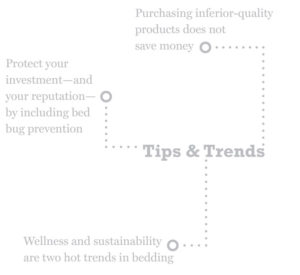 “Adults are recommended to get between seven and nine hours of sleep a night to aid in good health,” added Sandra DiVito, VP of sales, hospitality division, Protect-A-Bed. “Hotel beds come into intimate contact with each traveler and influence their perception of comfort, cleanliness and health of the entire property. Without a doubt, the hotel bed is one of the most influential areas of the hotel on a guest’s experience.”
“Adults are recommended to get between seven and nine hours of sleep a night to aid in good health,” added Sandra DiVito, VP of sales, hospitality division, Protect-A-Bed. “Hotel beds come into intimate contact with each traveler and influence their perception of comfort, cleanliness and health of the entire property. Without a doubt, the hotel bed is one of the most influential areas of the hotel on a guest’s experience.”
There are several trends influencing hotel beds these days. “Guest wellness continues to be a hot trend in the hospitality industry,” Sequeira said. “We are a sleep-deprived country. Studies prove it. Experts continue to stress the importance of getting the required amount of sleep in order to avoid serious health issues down the road. But nowhere is the need for a good night’s sleep more important than when you’re a business traveler. Your work performance suffers when sleep suffers. Period.
“Sustainability is another key trend that continues to be a priority initiative for the brands we serve,” he continued, noting that this ranges from zero-waste policies for factories, using raw materials that come from repurposed and recycled sources, and comprehensive recycling programs that keep mattresses out of landfills. “We hope sustainability initiatives like ours encourage other bedding manufacturers to follow suit,” he said.
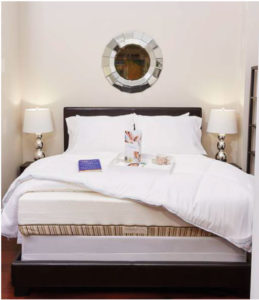
Welspun partnered with Delos for The Stay Well Wellness Collection, which uses innovative performance technologies, Dreamskin and Protx2TM, to offer a wellness-inspired sleep environment.
Hochschild noted that he’s seeing increased interest in high-quality pocket-coil mattresses at three- and four-star properties, as well as “the beginning of interest in modular sustainable mattresses with removable, interchangeable parts, because of their ability to have [longer]lifecycles, reducing the cost of bed ownership by 50% while cutting the solid waste generated by old hotel bed disposal by half over a 15-year period.” He also said that modular sustainable beds are beneficial when it comes to combatting bed bugs. “Modular sustainable beds can be treated for bed bugs internally using harmless food-grade diatomaceous earth, or DE,” he said. “This takes the bed out of the bed bug equation.”
And taking bed bugs out of the equation is important for guests. Roger Doyon, SVP/GM, CleanBrands LLC, noted that confidence that the bed is clean and safe from bed bugs is of the utmost importance for guests. “As bedding industry professionals, we are amazed by the number of beds we encounter that are not encased to protect against the harborage of bed bugs,” he said, noting that the biggest recent trend is an informed guest. “In fact, according to our recent guest survey of frequent travelers, over 80% of guests stated that they routinely inspect the bed and surrounding area upon entry into their room. That level of awareness should be a wake-up call to hoteliers who have neglected their bed bug inspections and bedding protocols.”
“The mindset of hoteliers has changed recently from reacting to bed bugs to preventing them,” added Joseph Latino, president, Allergy Technologies LLC. “There are a large variety of bed bug detection (monitoring) tools on the market. But products that truly prevent a bed bug infestation and protect not only the bedding, but the host sleeping in the bed, are garnering much more interest these days.” In addition to encasements, which demonstrate a protection of the capital asset (the mattress) and protection against staining, hotels are looking to other tools to aid in bed bug prevention, Latino said, citing the negative impact infestations have on reputation and RevPAR. “Recently, Orkin Pest Control partnered with The Bantam Group, a market research firm, to study the total cost of a bed bug incident, which they determined could be as high as $23,560 per incident including litigation and remediation. The study also determined that 82% of hotels agree that it is less expensive to prevent than to treat bed bugs. This study supports the shift in mindset of the bedding market toward products that not only claim—but can scientifically prove—the ability to prevent infestations from establishing,” he said.
What are owners and operators most interested in when it comes to mattresses and encasements? Hochschild noted that hotel owners look for value and long-term product performance. Doyon added, “Durability is paramount.” For his part, Sequeira noted that owners want “exceptional warranties and customer service to minimize their business disruptions. Due to the extensive use and wear hospitality products endure, strict adherence to brand guidelines and testing is critical to hotel customers.”
“Hoteliers desire products that perform consistently throughout their lifecycle, can help reduce costs and require little service,” DiVito agreed. “Hotels are busy environments, with many moving parts. Many owners look for efficiencies wherever they can gain them.”
She noted that efficiency is obtained when a waterproof, breathable mattress encasement is installed. “By adding an encasement to a hotel bed, hoteliers are able to improve the health of the sleeping environment for the guest,” she said. “Encasements also reduce housekeeping labor costs and chemical treatments through stain and pest prevention. The result is an increase of the life and integrity of the mattress.”
Latino noted that many hoteliers are looking at active mattress liners. “They are simple to install, constructed similar to a fitted sheet. They not only protect the mattress but the person sleeping on the mattress as well… Active mattress liners actually kill bed bugs,” he said.
And as for what goes on top of the mattress? “Brands continue to develop innovative fabrics and technology to address the growing needs of specific customers,” DiVito explained. “Encasements and protectors have long been providing enhanced cleanliness, durability and health. New fabric technology is allowing these essentials to provide benefits like allergen prevention, sleep-enhancing cooling and moisture wicking, making them an ideal sleep surface for a wide range of guests.”
“For the most part, top of bed is still white with accent colors for the pillows, skirts and scarves,” said Gary Kenney, principal, Kenco Hospitality. Filippo Arnaboldi, CEO of Frette, added, “Over the past few years, we’ve seen the clean, residential aesthetic emerge as one of the top trends in hospitality bedding. Neutral color schemes are being accented by subtle design touches, such as the vertical stripes of Frette’s Francesca Collection or the classic jacquards Frette is known for.”
For his part, Jon Bryant, Sferra’s sales director, hospitality, said, “Along with poly-cotton blends in sheeting, I am seeing printed embellishments becoming popular, although not at the luxury level. At the luxury level, pure, clean cotton is still king. However, we can add color embroidery stitching or perhaps use a jacquard to keep a clean, crisp look that’s so essential in hospitality.
“There are many other ways color can find its way into the bed,” he added. “Headboards are becoming a more important design element in hotel rooms. It allows for color, style, and a sense of true uniqueness, which luxury properties desire.”
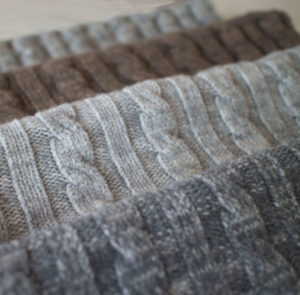
The Nomad Collection from Fil Doux Textiles and Clodagh includes textural cotton-blend designs including woven fabrics and digital prints, and a coordinating series of throw blankets in 15 earth-inspired colorways.
Kenney noted that, much like with mattresses, price is a factor for hoteliers when it comes to top-of-bed products. “But quality is every bit as important to the guest,” he said. “Comfort and keeping a fresh, current look are what clients are striving for.”
Bryant agreed. “Owners and operators at the ‘branded’ level have fewer options due to the brand standards they have to meet. However, at the luxury and boutique level, they are looking for ways to differentiate themselves. Their biggest concerns are, ‘Can I get the look my property needs/wants at a price that I can afford?’”
Arnaboldi added, “Hoteliers are continuously seeking out bed linens that allow guests to feel as though they are in their own home. That means linens with an exceptional quality, a stylish design, a comfortable feel and those offering the ability to easily maintain a pristine bed.”
The experts had tips for hoteliers looking to upgrade their bedding experience. “Stay with folks that deliver quality product and have been around for a while to stand behind the product provided,” Kenney said.
Arnaboldi agreed. “While quality, design and comfort are some of the most important factors when purchasing hotel bedding, it’s also important the linen provider you partner with offers professional and personalized service. Partnering with pioneers of the industry that are known for their excellence is more than just providing guests with a comfortable stay because it leaves a lasting impression,” he said.
“As with any purchase decision, consider total cost of ownership over acquisition cost,” Doyon said. “Additionally, understand the implications of not using an encasement.”
But cost isn’t the only factor—quality is too. “Don’t ever skimp on quality by focusing solely on the cost,” DiVito added. “Purchasing inferior quality products does not save money. When that product fails due to quality in materials and manufacturing, hoteliers will incur additional costs replacing product and tripling their installation expense.”
Sequeira echoed Kenney’s point about working with a known manufacturer. “Do work with a bedding solutions provider that understands the unique needs of the hospitality market and can design and deliver products that not only meet their operational needs, but also an exceptional, brand-defining guest sleep experience,” he said. “In a social network-driven marketplace, keeping guests happy has never been more important. Consumer products are simply not designed to withstand the rigors of a hotel guestroom—and most will not honor warranties for this environment. Look for providers with established track records of not only product performance, but the ongoing service and support required to minimize business disruptions. Keeping rooms in service is a hotel’s primary objective, so it’s important to work with suppliers that have operations designed to accomplish this goal.”
Hochschild ticked off a list of advice: “Do bring in bed samples a year before you plan to buy beds—all new beds are comfortable, so it’s a guess if you don’t test; do look at modular sustainable beds; do add $40 per unit to your bed budget so you can insist on Genuine Leggett & Platt pocket coils; do ask fellow operators for the name of their bed supplier if you like their beds; do get a list of references of customers who bought beds at least five years ago; do ask where the springs and foam come from.”
Similarly, when it comes to top of bed, Bryant said, “Hoteliers looking at their bedding options need to be focused on quality and durability as well as aesthetics. Being knowledgeable about the advantages of long-staple cotton fiber length—as it pertains to the overall feel and life of the bedding—is a great bit of knowledge to have. Knowing the difference between a sateen and a percale is helpful. Consider whether they use a commercial laundry or will they have an on-premises laundry facility? And an important tip: Ask the manufacturer for a set of sheets and take them home and sleep on them because you want to experience what your guests will be experiencing at your hotel.”
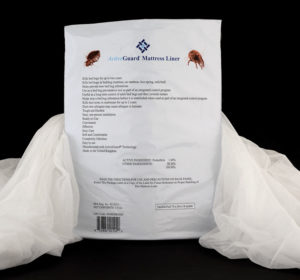
Allergy Technologies’ ActiveGuard Mattress Liners kill bed bugs and dust mites providing control and prevention 24/7 for two years, according to the company. Four sizes fit almost every bed available.
What can we expect from the bed of the future? “Hotel brands continually look for the next, best, latest, greatest thing,” Sequeira said. “Brands want to be differentiated. Just because something might be great at one hotel, they might feel that, ‘Hey, how can it be even better at my hotel? How can that be part of my brand? How can we capitalize on the fact that we’re offering something unique and something different that nobody else has?’”
For her part, DiVito said, “As we move into the future, we’ll see the integration of more thermal-regulating products into the mattress and bedding realm. Products like the Snow Cooling Pillow will be common, as the benefits of an ideal temperature during sleep have been well documented. Besides, who wants to sleep hot?
“Beyond temperature, expect the subject of sleep itself to get much more attention, and for hotels to increase their investments in this area,” she continued. “Awareness of the impact that a quality sleep can have on your day and life is growing. Future travelers will favor hotels where they know they’ll get the rest they need to be their best. Also, consider smart technology to make an appearance—from smart alarm clocks to the ZEEQ Smart Pillow and integrated devices like automated lights. The future is bright.”
Bryant noted, “Cotton is and will be king for the foreseeable future in the luxury market. It is the workhorse of the luxury hotel market because it’s breathable, clean, crisp, and durable and provides the highest comfort in bedding.”
Arnaboldi concluded, “Hotel beds and guestrooms will continue to evolve according to guest preferences while remaining true to the aesthetic of the property. A hotel that has historically welcomed guests with a residential feel rather than an ornate design scheme will evolve in a similar fashion and vice versa. In the bedding market, there is constant innovation, especially in terms of the textile finesse and weaving technologies.”
Ultime from Ligne Roset and Philippe Nigro features a headboard and bed covered in foam. The headboard is one area where hotels can incorporate color.
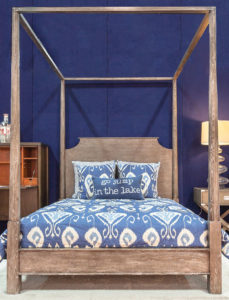 Blue Leaf Hospitality’s Greenwich Four Poster Bed offers clean, straight lines of the bed frame balanced by the curved design of the headboard.
Blue Leaf Hospitality’s Greenwich Four Poster Bed offers clean, straight lines of the bed frame balanced by the curved design of the headboard.
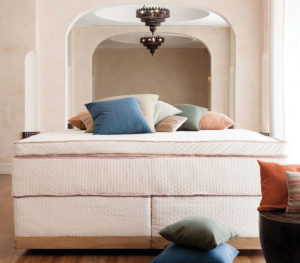 Coco-Mat’s Triton is a sleep system that combines a bed foundation, mattress and top-mattress. Built up in multiple layers, a combination of natural materials is used in every part of Triton. Seaweed and eucalyptus leaves emit a refreshing scent, while horsehair and cactus regulate humidity. The plush cover is available in four colors.
Coco-Mat’s Triton is a sleep system that combines a bed foundation, mattress and top-mattress. Built up in multiple layers, a combination of natural materials is used in every part of Triton. Seaweed and eucalyptus leaves emit a refreshing scent, while horsehair and cactus regulate humidity. The plush cover is available in four colors.
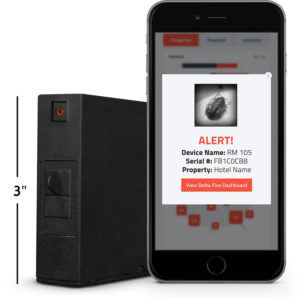 Delta Five offers a device that autonomously detects and captures pests. This device will alert users of detected pests via an email and/or text message. The dashboard shows users the status of and images from multiple devices.
Delta Five offers a device that autonomously detects and captures pests. This device will alert users of detected pests via an email and/or text message. The dashboard shows users the status of and images from multiple devices.
 The Plisse Bed by Koket has a design that evokes a sense of vintage glamour, according to the company. As its French-derived name suggests, the bed is fully upholstered with a puckered texture and is available in any fabric from the Koket Textiles collection, including leather (shown).
The Plisse Bed by Koket has a design that evokes a sense of vintage glamour, according to the company. As its French-derived name suggests, the bed is fully upholstered with a puckered texture and is available in any fabric from the Koket Textiles collection, including leather (shown).


